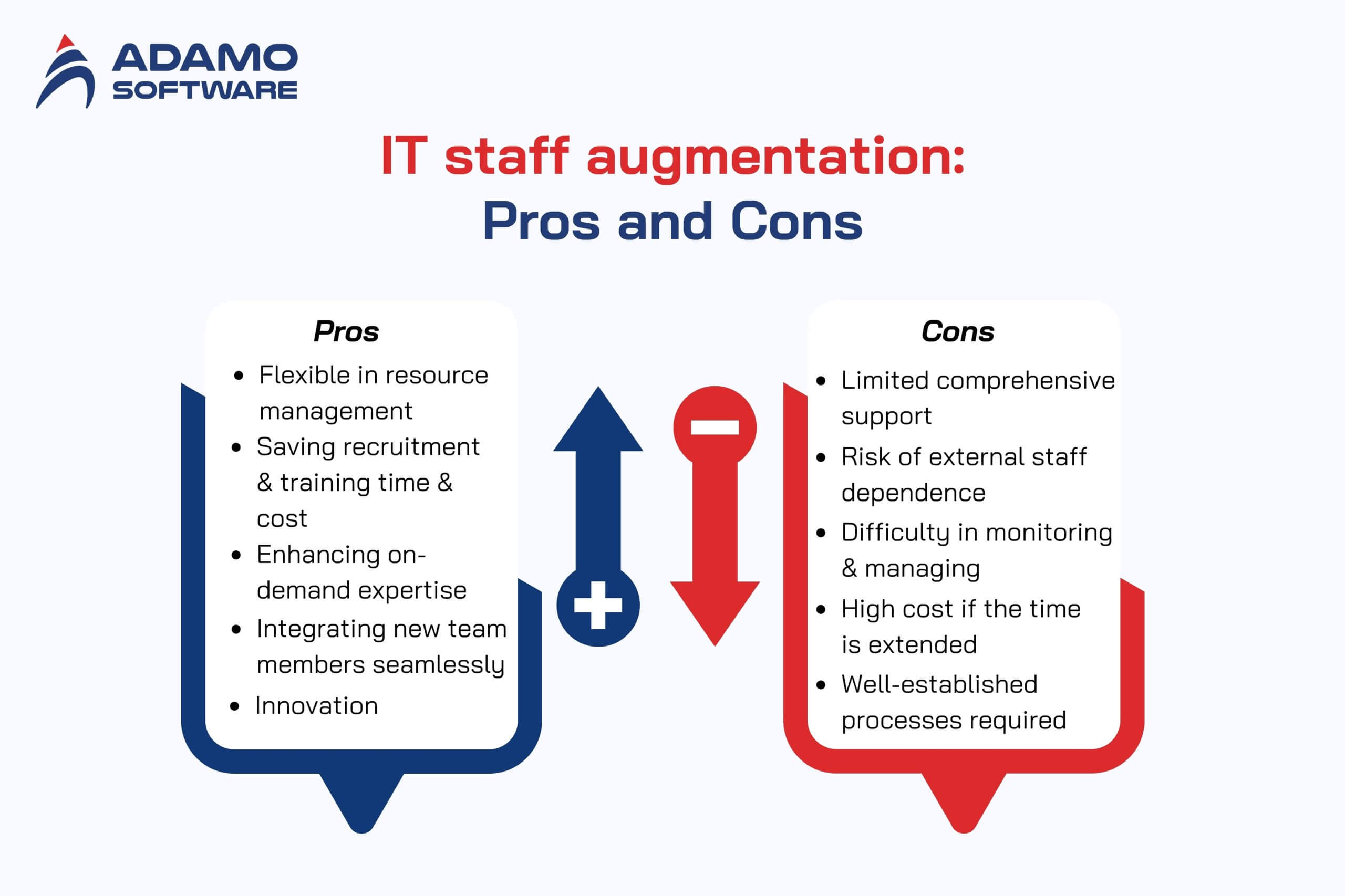IT staff augmentation vs managed services: What model to choose

Currently, outsourcing IT human resources has become popular for businesses. However, choosing between IT staff augmentation vs managed services is a matter of concern. Choosing the right model can directly affect business performance and costs. IT staff augmentation allows businesses to add IT personnel without expanding internal human resources. Whereas, with a managed services model, businesses can use the IT services from a third party. So, which model you should choose for your business? Let’s find more detailed information on each model with Adamo Software!
Through this blog post, you will have an overview of IT staff augmentation vs managed services. Besides, the differences between these two models are also discussed. Adamo Software also shows you the key differences between these two models. All information has been thoroughly researched and updated to the latest trends. So, let’s read our blog post and find useful information for you!
I. IT staff augmentation vs managed services: What are they?
IT staff augmentation vs managed services, these two models both help businesses support the management and expansion of IT capabilities. Businesses seeking adaptability in HR and IT management will find unique advantages in these solutions. IT staff augmentation provides supplementary personnel to address short-term project needs or augment existing capacity. Conversely, managed services outsource complete IT operations to specialized vendors. So, IT staff augmentation vs managed services, which model is suitable for your business? Let’s discuss to determine your answer!
1. What is IT staff augmentation?
IT staff augmentation is a flexible staff outsourcing model that allows businesses to add IT personnel according to their needs without direct recruitment. This model enables you to hire staff from outside to perform urgent or short-term tasks and projects quickly and effectively. This team can also help you handle emerging and surge work or fill skills gaps within internal teams. Thanks to this, you can easily scale up or down your IT staff when you need to without long-term hiring and managing additional staff costs.
One of the significant features of the IT staff augmentation model is its ability to provide qualified human resources in a short time. It is especially useful when your business needs specialized professionals such as programmers, security experts, or systems engineers. Additionally, this model empowers businesses to oversee and direct their internal IT staff. New hires will collaborate directly with the existing team, eliminating the need to outsource the entire system to an external provider.
When making an IT staff augmentation vs managed services comparison, the IT staff augmentation helps businesses proactively monitor and coordinate work, ensuring that additional personnel fit the company culture and can easily adjust to changing requirements. This model is especially useful for companies that need flexibility in personnel or have short-term projects, but still need to maintain control and continuity in work. Therefore, when comparing IT staff augmentation vs managed services, you must carefully consider the need for flexibility and the desire to maintain internal control.
2. What are managed services?
Managed services model is a model in which businesses enlist a third party, often called a managed service provider (MSP), to manage all or parts of their IT operations. With this model, you can focus on your business’s core activities and reduce workloads. In the context of IT staff augmentation vs managed services comparison, managed services are an ideal choice for businesses that want to offload IT responsibilities and seek long-term, stable support from an outside team of experts. Thanks to this model, your business can optimize operating costs, enhance security and performance. This model also allows you to control your monthly IT costs.
With the managed services model, the MSP will be responsible for managing, monitoring, and ensuring that the business’s IT system runs smoothly. Thanks to this, businesses using the model can reduce the risks related to internal management, costs, and time. The service providers can participate in one process in the IT system or manage the whole system depending on the requirements of the business. Some featured areas include system maintenance, security, data backup, user support activities, etc.
When comparing IT staff augmentation vs managed services, managed services can provide a more comprehensive solution for businesses. Instead of adding staff to the existing team, this model allows your business to completely entrust most or all the IT system to an outside professional team. This is especially suitable for businesses that do not have the resources or expertise to manage IT comprehensively. Or simply, when they want to minimize internal human resource management problems, they may consider using this model.
II. IT Staff augmentation: Pros and Cons
As mentioned, using the IT staff augmentation model, businesses can hire outside experts for a project without long-term recruitment. However, to decide whether to choose this model, besides making an IT staff augmentation vs managed services comparison, you may want to know the pros and cons of each model. Let’s start with the IT staff augmentation.

1. The advantages of the IT staff augmentation model
The IT staff augmentation model brings benefits to businesses thanks to its flexibility in adding personnel and resources for the IT project. When comparing the IT staff augmentation vs managed services, this model is outstanding with the ability to help businesses easily increase expertise on demand without long-term recruitment. Below are some advantages of this model.
- Flexible in resource management
Depending on the size and needs of the project, your business can easily increase or decrease the number of IT staff. Unlike managed services, IT staff augmentation lets you keep control of your in-house team while avoiding outsourcing the whole system.
- Saving recruitment and training time and cost
Recruiting and training in-house team staffs can be costly and time-consuming. By leveraging IT staff augmentation or managed services, organizations can rapidly access a pool of skilled professionals, potentially saving both time and financial resources compared to traditional recruitment methods.
- Enhancing on-demand expertise
When you want to add specific skills without investing in long-term recruitment, IT staff augmentation is an ideal choice. This model allows you to select personnel with specialized skills that meet the exact requirements of the project.
- Integrating new team members seamlessly
One of the major advantages of IT staff augmentation is the smooth integration of new team members into your company’s existing team. When comparing staff augmentation vs managed services, it can be easily seen that this model allows additional staff to work directly with the internal team. This makes additional team members easily integrate into the company’s processes and culture. Thanks to this, your business can enhance synchronization and optimize work performance without changing the management structure.
- Innovation
The IT staff augmentation brings innovation to your business by accessing IT experts with diverse perspectives and skills. By adding personnel from outside, your business can tap into fresh ideas, drive innovation, and improve processes. Comparing IT staff augmentation vs managed services, both models help enrich creative thinking by bringing in experienced employees from a variety of backgrounds.
2. The disadvantages of IT staff augmentation
The IT staff augmentation is a flexible and quick solution for businesses that want to add IT personnel in a short time. However, this model also has some disadvantages that you may want to note when choosing between IT staff augmentation vs managed services. Let Adamo Software discuss some featured cons of this model.
- Limited comprehensive support
When comparing the IT staff augmentation vs managed services, the IT staff augmentation only provides additional manpower without comprehensive management services. Therefore, your business still needs to monitor and operate the daily work of the IT team. Although you have the right to proactively control, this requires a lot of time and resources.
- Risk of external staff dependence
When you use the IT staff augmentation service, you will face the risk of external staff dependence. This can affect the continuity and quality of the project if the additional staff stop cooperating.
- Difficulty in monitoring and managing
The IT staff augmentation requires your business to manage and supervise additional staff alongside the internal team. This leads to complex coordination, especially in large projects or when many IT staff are involved.
- High cost if the time is extended
The IT staff augmentation can save recruitment costs for in-house human resources. However, comparing IT staff augmentation vs managed services, the outsourcing costs can increase significantly if your company’s project is extended. This can put pressure on your business’s budget.
- Well-established internal processes required
Another downside of IT staff augmentation is the need for robust internal systems to rapidly onboard new team members. When comparing IT staff augmentation vs managed services, the staff augmentation model necessitates businesses to directly manage and coordinate the work of additional staff within their existing frameworks. If the processes are unclear, the integration of new staff will be ineffective and may slow down the project.
III. Managed Services: Pros and Cons
When comparing IT staff augmentation vs managed services, the managed services model also has specific pros and cons. Let’s discuss the advantages and disadvantages of this model with Adamo Software!

1. The pros of managed services
The managed services model is ideal for businesses that want to optimize their IT operations without directly managing. With this model, businesses can pass parts or all IT processes to a third party, ensuring the consistency, security, and efficiency of the IT system. When comparing IT staff augmentation vs managed services, the managed services stand out for their comprehensiveness, helping businesses focus resources on important strategic goals. Below are the specific advantages of managed services in supporting and improving operational efficiency.
- Optimizing costs
offer businesses a cost-effective approach to IT management. By opting for fixed service packages, businesses can accurately forecast and control their IT budgets. This model eliminates the need for recruiting and training in-house IT staff, further reducing costs.
- Comprehensive and continuous support
With 24/7 support services, managed services ensure that IT systems are constantly monitored, and issues are addressed promptly, helping to minimize risks and downtime. Comparing IT staff augmentation vs managed services, businesses using managed services do not need to handle the daily operations of the IT system.
- Enhancing security
Managed services often include comprehensive security solutions with measures such as network security monitoring, threat detection, and prevention. The service providers have distinctive tools and security experts. Thanks to this, your business can reduce the risk of cyber-attacks compared to self-managing IT personnel as in IT staff augmentation.
- Accessing to the latest technology
Managed services providers regularly update advanced technology and techniques to ensure the system always operates at high performance. When comparing IT staff augmentation vs managed services, managed services can help businesses immediately use modern technologies without investing in new technology themselves.
Overall, the managed services model is a comprehensive and cost-effective solution for businesses that want to maintain IT system performance without having to manage or add staff themselves. When considering IT staff augmentation vs managed services, businesses should choose managed services if they prioritize stability, and security, and need long-term support.
2. The cons of managed services
Although managed services bring many benefits for businesses thanks to their comprehensive and continuous support, they still have limitations. When comparing IT staff augmentation vs managed services, businesses must understand the disadvantages of managed services to consider the right choice. Issues such as loss of direct control, service costs, and vendor dependency can all affect the effectiveness of IT management. Below are the main disadvantages of managed services that businesses need to be aware of.
- Losing direct control
When transferring IT operations to a provider, you must accept less direct control over systems and data. Compared to IT staff augmentation, managed services make it difficult for businesses to track work progress and minor changes in IT systems.
- High service costs
Managed services often come with fixed service packages, but if customization is required or new needs arise, costs can increase. Compared IT staff augmentation vs managed services, in managed services, businesses may have difficulty controlling costs if the provider increases prices or requires additional fees.
- Vendor dependency risk
When choosing managed services, businesses risk depending on a single provider. If the provider has problems or changes regulations, businesses may face service disruptions. This is different from IT staff augmentation, where businesses can flexibly replace or supplement personnel from different sources.
- Lack of flexibility for rapid change
Managed services are often suitable for long-term and stable needs, but lack flexibility when businesses need to make rapid changes to systems or expand projects suddenly. Compared to IT staff augmentation vs managed services, IT staff augmentation is more adaptable when businesses need to make sudden changes in staffing or systems.
In general, the managed services model is suitable for businesses that want to stabilize their IT systems without having to manage the details themselves. However, when comparing IT staff augmentation vs managed services, managed services have limitations in terms of control, cost, and flexibility. Therefore, you must carefully consider the stability of managed services and the flexible control of IT staff augmentation to choose the right model for your long-term development needs.
IV. IT staff augmentation vs Managed services: Key differences to choose
When choosing between IT staff augmentation vs managed services, you may consider the cost, security, scalability, flexibility, and level of control. So, what are the differences between these two models? Let’s find out the answers with Adamo Software!

1. Costs
When comparing IT staff augmentation vs managed services in terms of cost, you need to consider carefully so that you can choose the model that suits your budget and project size, because each form has a different pricing structure. For the IT staff augmentation model, the costs depend on the number and level of outsourcing IT personnel, suitable for short-term projects.
However, if the need for staff is prolonged, costs can increase and become inefficient. Whereas the managed services model normally has a fixed monthly fee based on the service package, making it easy for businesses to budget. However, if you require customized or advanced services, the cost can increase.
2. Security
Security plays an important role in choosing between IT staff augmentation vs managed services. The reason is that each model has different levels of data protection and system security, which are suitable for different enterprise security needs. With the IT staff augmentation model, you will have to manage and monitor security for the IT team yourself. This requires your business to have strong security processes and clear policies to protect data, especially when working with outside personnel.
In contrast, the service providers for the managed services model have a professional security system and 24/7 monitoring, helping to minimize security risks. Comparing IT staff augmentation vs managed services, managed services provide a more comprehensive security solution thanks to a team of experts and modern technology.
3. Scalability
Using IT staff augmentation, your business can easily extend or reduce the number of staff depending on its requirements. This creates flexible management of resources. Compared to IT staff augmentation, managed services also support scalability, but service adjustments often require negotiation and can be time-consuming. With a fixed service plan, however, managed services can scale steadily as your business grows.
4. Flexibility
When evaluating the IT staff augmentation vs managed services in terms of flexibility, your business must consider the ability to adapt to changes in the projects’ requirements and human resources management, as each model brings a different level of flexibility. When your business needs to quickly increase for short-term projects or change IT staffing structure, IT staff augmentation will be an ideal choice. This model brings high flexibility, allowing you to self-manage, coordinate, and change staff as needed.
On the other hand, the managed services model’s flexibility is more limited because the service is standardized. If you want to make any changes, you must go through the provider. This may require additional fees or adjustment time.
5. Level of control
The level of control is an important difference between IT staff augmentation vs managed services, as each model provides businesses with different levels of management and oversight over the project and IT team. For IT staff augmentation, your business retains control over IT staff, including day-to-day decisions on coordination and oversight. This model is particularly suitable for companies that want to self-manage and closely monitor project progress.
Conversely, the managed services model’s service providers are responsible for managing and coordinating IT work, which means the business has less direct control. However, for businesses that want to reduce the burden of management, managed services are the ideal solution.
V. Managed services vs IT staff augmentation comparison table
Below is a comparison table between IT staff augmentation based on important factors like process, billing, project type, hiring, employee benefits, and best use cases. Enterprise self-manages the project; additional personnel will work directly with the internal team.
| Elements | IT staff augmentation | Managed services |
| Process | Enterprise self-manages the project, additional personnel will work directly with the internal team | Responsible for managing and operating the entire IT system of the enterprise |
| Billing | Hourly or monthly billing, based on contract with outsourced IT staff | Fixed monthly or annual service fee, additional costs may apply if customization is required |
| Project type | Short-term projects that require rapid addition of skills or manpower | Long-term projects or projects requiring system stability and maintenance |
| Hiring | Businesses need to select and hire additional employees based on specific skills | No need to recruit; the service provider provides a team of experts |
| Employee benefits | The company can decide on the benefits and working conditions for additional staff. | Providers manage and are responsible for their employees’ benefits |
| Best use cases | Suitable when quick addition of expertise is needed for special or short-term projects | Suitable for long-term IT system management, security, 24/7 technical support |
Overall, managed services is a good choice when businesses need long-term stability and reduced management responsibilities. Meanwhile, IT staff augmentation is more flexible in meeting short-term needs or projects that require specific skills.
Also read: Dedicated team vs Extended team: A guide to opting for the best fit
VI. What model to choose with Adamo Software
Choosing between IT staff augmentation vs managed services can be made easier when you find a trusted partner like Adamo Software. As one of Vietnam’s leading companies in technology, we can provide you with flexible solutions for your business. Adamo’s dedicated development team model can combine the best of both IT staff augmentation and managed services, ensuring ongoing support like managed services, while maintaining control and flexibility like IT staff augmentation. If you want to optimize costs and resources and maintain a high level of control over IT projects, Adamo Software’s solution can be your ideal choice. Here are some benefits of choosing a dedicated development team with Adamo.

- Specialized and highly skilled team
Adamo selects and trains personnel with extensive specialized skills. This helps you easily add high-quality resources without a complicated recruitment process.
- Maintaining control
With a separate development team, you still have direct control over the process and progress. This ensures that your project is developed in the right direction.
- Flexibility and scalability
When there is a need to expand the project or change requirements, Adamo can easily adjust the number and skills of the team. So, your business can always be ready for changes.
- Long-term cost savings
Compared to internal recruitment or self-managing IT staff augmentation and managed services, Adamo’s solution optimizes costs by providing competitive prices for dedicated development teams.
If you are hesitating to choose between IT staff augmentation vs managed services, Adamo’s dedicated development team can be your ideal choice. Let’s contact our team and we will answer all your questions.











